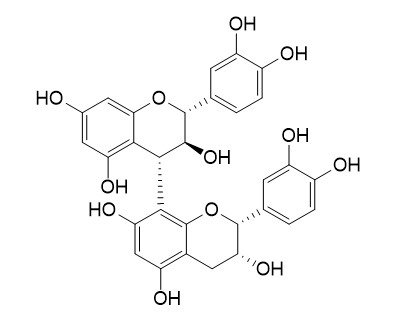Procyanidin B4
Procyanidin B4 reveals significant antioxidant activity.
Inquire / Order:
manager@chemfaces.com
Technical Inquiries:
service@chemfaces.com
Tel:
+86-27-84237783
Fax:
+86-27-84254680
Address:
1 Building, No. 83, CheCheng Rd., Wuhan Economic and Technological Development Zone, Wuhan, Hubei 430056, PRC
Providing storage is as stated on the product vial and the vial is kept tightly sealed, the product can be stored for up to
24 months(2-8C).
Wherever possible, you should prepare and use solutions on the same day. However, if you need to make up stock solutions in advance, we recommend that you store the solution as aliquots in tightly sealed vials at -20C. Generally, these will be useable for up to two weeks. Before use, and prior to opening the vial we recommend that you allow your product to equilibrate to room temperature for at least 1 hour.
Need more advice on solubility, usage and handling? Please email to: service@chemfaces.com
The packaging of the product may have turned upside down during transportation, resulting in the natural compounds adhering to the neck or cap of the vial. take the vial out of its packaging and gently shake to let the compounds fall to the bottom of the vial. for liquid products, centrifuge at 200-500 RPM to gather the liquid at the bottom of the vial. try to avoid loss or contamination during handling.
Foods.2022, 11(12):1773.
Int J Mol Sci.2022, 23(11):6172.
J Nat Prod.2017, 80(4):854-863
Molecules.2022, 27(21):7514.
Evid Based Complement Alternat Med.2017, 2017:1401279
Nutrients.2020, 12(12):3638.
J Chromatogr B Analyt Technol Biomed Life Sci.2019, 1124:323-330
Applied Biological Chemistry2022, 65(77).
Sci Rep. 2018, 10590
The Journal of Korean Medicine2023, 44(4):26-40.
Related and Featured Products
Acta Biochim Biophys Sin (Shanghai). 2019 Jan 1;51(1):31-40.
Lotus seed skin proanthocyanidin extract exhibits potent antioxidant property via activation of the Nrf2-ARE pathway.[Pubmed:
30544155 ]
Lotus seed is well known as traditional food and medicine, but its skin is usually discarded. Recent studies have shown that lotus seed skin contains a high concentration of proanthocyanidins that have multi-functions, such as antioxidation, anti-inflammation, and anti-cancer effects.
METHODS AND RESULTS:
In the present study, we aimed to isolate and purify the proanthocyanidins from lotus seed skin by acetone extraction and rotary evaporation, identify their chemical structures by HPLC-MS-MS and NMR, and further investigate the antioxidant properties of the extract purified by macroporous resin (PMR) from lotus seed skin both in vitro and in vivo. The results showed that PMR mainly contained oligomeric proanthocyanidins, especially dimeric procyanidin B1 (PB1), procyanidin B2 and Procyanidin B4. Although it had limited ability to directly scavenge radicals in vitro, PMR could significantly enhance the expressions of antioxidant proteins via activation of nuclear factor-E2-related factor 2 (Nrf2)-antioxidant response element (ARE) pathway in HepG2 cells.
Molecular data revealed that PB1, a major component in PMR, stabilized Nrf2 by inhibiting the ubiquitination of Nrf2, which led to subsequent activation of the Nrf2-ARE pathway, including the enhancements of Nrf2 nuclear translocation, Nrf2-ARE binding and ARE transcriptional activity. Moreover, the in vivo results in high fat diet-induced mice further verified the powerful antioxidant property of PMR.
CONCLUSIONS:
These results revealed that lotus seed skin is a promising resource for functional food development.
Drug Discov Ther. 2015 Dec;9(6):391-6.
Comparison of compounds of three Rubus species and their antioxidant activity.[Pubmed:
26781923 ]
Rubus amabilis, Rubus niveus Thunb., and Rubus sachalinensis are three Rubus species that are alternatively found in Manubzhithang, a Tibetan medicine, in different areas of China.
METHODS AND RESULTS:
The current study analyzed HPLC/UV chromatograms and it compared compounds of these three Rubus species in contrast to reference substances such as 2,6-dimethoxy-4-hydroxyphenol-1-O-β-D-glucopyranoside, Procyanidin B4, and isovitexin-7-O-glucoside. The three Rubus species produced similar peaks in chromatograms. The antioxidant activity of the three Rubus species was determined using an assay for DPPH free radical scavenging activity. Results indicated that the three Rubus species extracts had almost the same level of free radical scavenging activity.
CONCLUSIONS:
Thus, findings indicated the rationality of substituting these species for one another as an ingredient in Manubzhithang.
Food Chem. 2015 May 1;174:480-6.
Synthesis, characterisation and antioxidant features of procyanidin B4 and malvidin-3-glucoside stearic acid derivatives.[Pubmed:
25529709 ]
The acylation of Procyanidin B4 with a saturated fatty acid chloride containing 18 carbon atoms was studied in order to obtain Procyanidin B4 3-O-di-stearic acid conjugate.
METHODS AND RESULTS:
This compound was structurally characterised by mass spectrometry and 1D and 2D NMR techniques. Derivatization of malvidin-3-glucoside using stearoyl chloride in acetonitrile was also performed yielding mono-, di- and tri-stearic ester derivatives.
CONCLUSIONS:
The novel derivatives obtained revealed significant antioxidant activity, although lower than the respective precursors. However, the chemical modification of anthocyanins and procyanidins (water soluble pigments) to more lipophilic compounds has the advantage of increased bioavailability in biological matrices, and to potentiate their application in food matrices and cosmetic products.



